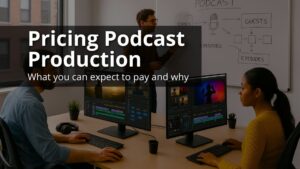Are you wondering if your podcast is performing well? Knowing what podcast download numbers are considered good is crucial for assessing your show’s success. Whether you’re aiming to attract sponsors, grow your audience, or simply gauge your progress, understanding how to measure your podcast metrics is key.
It is also important to know if the numbers you are measuring are podcast vanity numbers or metrics focused on growing your brand. Are you trying to reach unknown masses of people or a specific audience?
If you are focused on business results and brand awareness, you should also read this article on measuring branded business podcasts.
Where do you measure your podcast? Apple, Spotify, or the file host?
First Understand – There is No Centralized Podcast Data.
The source of truth for podcast measurement should always start with the audio file host, such as Transistor.fm, Libsyn, Buzzsprout, etc.
Relying solely on analytics from individual platforms like Spotify and Apple Podcasts can present an incomplete and inconsistent picture of your podcast’s performance. Each platform employs its own metrics and definitions for user engagement, leading to potential discrepancies in data interpretation.
For instance, Apple Podcasts provides listener analytics that focus on aggregated listening completion rates from unique devices for each episode, offering insights into how users engage with your content on their platform. However, these metrics are specific to Apple Podcasts and may not align with data from other platforms.
Meanwhile, Spotify metrics are confined to Spotify’s user base and may not represent your podcast’s performance across other platforms. Additionally, Spotify’s analytics include data on listener demographics and behaviors, which, while useful, are tailored to Spotify’s ecosystem and may not align with metrics from other platforms.
In contrast, podcast hosting services like Transistor.fm or Libsyn aggregate data across all platforms where your podcast is available, providing a more holistic view of your audience engagement. These hosts track downloads and listens from various sources, offering comprehensive analytics that reflect your podcast’s overall performance. This centralized data collection is crucial for understanding your true reach and making informed decisions about content and marketing strategies.
It’s also important to recognize that each platform may have its own agenda influencing how they report data. For example, platforms might prioritize metrics that highlight their user engagement to attract advertisers, potentially leading to a skewed representation of your podcast’s performance. By depending solely on platform-specific analytics, you risk basing your strategies on partial or biased data.
Therefore, to obtain the most accurate and actionable insights, it’s advisable to rely primarily on the analytics provided by your podcast hosting service. These platforms are designed to offer unbiased, comprehensive data, enabling you to assess your podcast’s success effectively and tailor your content to meet your audience’s needs.
When Additional Podcast Measurement Tools Might Be Worth Adding
Your host platform will cover most of what you need. It is solid and most factual.
But depending on your goals, there are a few other platforms worth knowing about. These tools can help in specific scenarios like advanced marketing attribution, preparing for sponsorships, or increasing discoverability. That said, they each come with setup steps and, in some cases, added costs.
Chartable
- Use it for: Tracking where listeners come from and which campaigns drive results.
- What it does: Chartable adds a tracking prefix to your RSS feed so you can see if someone came from a social post, ad, newsletter, or guest appearance. It also helps track repeat listener behavior.
- What it requires: You’ll need to modify your RSS feed and create special SmartLinks for tracking campaigns. Chartable offers a free tier, but attribution and deeper reporting features require a paid plan. This is a change to how your content is found and must be remembered in case you need to make changes in the future.
- When to use it: If you’re investing in marketing or want to measure ROI from guest spots or paid ads.
Podtrac
- Use it for: IAB-compliant audience data and credibility with advertisers.
- What it does: Podtrac tracks unique monthly listeners and downloads, then benchmarks your show within your category. It’s commonly used in media kits and ad deals.
- What it requires: Add Podtrac’s tracking prefix to your RSS feed and maintain a separate login to check data. Podtrac is free but must be set up intentionally. As with other changes to your RSS feed URL, this is a change to how your content is found and must be remembered in case you need to make changes in the future.
- When to use it: If you’re seeking sponsorships or need standardized reporting for media buyers.
Podchaser
- Use it for: Public visibility, guest tracking, and discoverability – not listener data.
- What it does: Podchaser functions more like IMDb for podcasts. It shows your public ratings, guest appearances, and chart placements. You can also use it to build a profile and expand networking opportunities.
- What it requires: You’ll need to claim and manage your profile manually. Pro features (like contact data or advanced research tools) come with a cost.
- When to use it: If you’re building public reputation, booking guests, or trying to increase show visibility.
If you just want to track growth and make data-driven decisions, your host platform is enough. But if you’re marketing aggressively, courting sponsors, or managing your public brand presence, these tools can add value—as long as you’re aware of the extra steps and decide if they’re worth the investment.
Podcast Downloads versus Streams:
Downloads
- Measuring Success: Downloads show how many people have saved your episodes to their devices, offering a clear indication of genuine interest in your content.
- Pros:
- Reliable Metric: Downloads are a strong indicator of committed listeners because they’ve taken the step to save your episode.
- Offline Listening: Reflects a dedicated audience who want access to your content even without internet access.
- Better for Sponsors: Advertisers often prefer download numbers as they imply a higher level of engagement and commitment.
- Accessible Data: Your podcast hosting platform can reliably track and report download numbers, making it easier to measure success.
- Consistency: Since your platform doesn’t show streams, downloads provide a single, consistent metric for measuring your podcast’s performance.
- Cons:
- Storage Limits: Some listeners might delete episodes after listening, which means repeated downloads may not reflect unique listeners.
- No Real-Time Feedback: Downloads don’t show when or if the episodes are actually listened to.
Streams
- Measuring Success: Streams indicate how many times your episodes are played directly from the internet.
- Pros:
- Real-Time Data: Streams provide more immediate feedback on how your episodes are performing.
- Continuous Engagement: Streams can show trends over time, like which parts of an episode are most popular.
- Accessibility: Easier for casual listeners to engage with your content without committing to downloads.
- Cons:
- Internet Dependence: Streaming numbers can be affected by listeners’ internet availability.
- Less Commitment: Streams might include listeners who play the episode briefly and then stop, providing a less accurate picture of dedicated engagement.
- Inconsistent Metrics: Streaming data can vary across different platforms, making it harder to get a consistent measure of success.
- Unavailable Data: Your platform doesn’t provide streaming data, making it an unreliable metric for you.
Using Both Metrics
- Comprehensive Insight: While downloads are more reliable for gauging long-term engagement, streams can still provide valuable real-time insights if available.
- Downloads: Indicate dedicated listeners and potential for offline engagement, easily tracked by your hosting platform.
- Streams: Offer insights into immediate interest and engagement trends, though less consistently.
Which is best to measure podcasts – Downloads or Streams?
- Downloads are the more reliable metric for understanding long-term engagement and committed audience size, especially since your podcast hosting platform can provide this data consistently.
- Streams provide additional real-time feedback and highlight trends, but are less dependable due to variability, less committed listeners, and unavailability on your platform.
- Focusing on downloads gives you a clearer and more consistent view of your podcast’s success and helps tailor your content strategy to better meet your audience’s preferences.
Social Media vs. Podcasts:
Podcast downloads typically grow slower than social media stats. This is because podcast downloads represent a more committed listener base. Social media engagement can be quick and superficial, while podcast listeners often dedicate significant time to consuming content.
Industry-Wide Podcast Download Statistics
Hosting Platform Data
Different hosting platforms provide varied benchmarks for podcast success. Here are the statistics from two popular platforms:
Buzzsprout: Buzzsprout measures downloads over a seven-day period. Their benchmarks are:
- More than 30 downloads places your podcast in the top 50% of shows.
- More than 105 downloads places your podcast in the top 25%.
- More than 405 downloads places your podcast in the top 10%.
- More than 975 downloads places your podcast in the top 5%.
- More than 3,600 downloads places your podcast in the top 1%.
Libsyn: Libsyn measures downloads over a 45-day period. Their benchmarks are:
- More than 154 downloads places your podcast in the top 50% of shows.
- More than 1,200 downloads places your podcast in the top 20%.
- More than 3,400 downloads places your podcast in the top 10%.
- More than 8,100 downloads places your podcast in the top 2%.
Creating Your Own Success Metrics
As we mentioned earlier, if you have an industry specific podcast and your goal is brand growth, none of these stats may matter. Your total addressable market may be smaller than a vanity number of podcast downloads. Also, you may be targeting a specific listener instead of trying to reach the masses.
Organic Network Approach:
- Identify your personal and social media networks. Consider how many people are in your immediate and extended networks.
- Estimate the percentage of these contacts likely to subscribe to your podcast.
- Set an initial download goal based on this estimate. For example, if you have 1,000 contacts and estimate a 10% subscription rate, aim for 100 downloads per episode.
Time Worth Calculation:
- Define what download number justifies your effort. Consider the time and resources you invest in producing each episode.
- Adjust goals based on audience size and niche. Smaller niches might have lower download numbers but higher engagement rates.
Monetization Goal:
If you aim to monetize your podcast through advertising, strive for at least 5,000 downloads per episode. This number is a general threshold that attracts potential advertisers.
Track Your Progress
Regularly monitor your download numbers to adjust goals and strategies. Use analytics provided by your hosting platform to understand listener behavior and trends.
For more podcasting tips and strategies, talk to us at Content Monsta. We can help you towards podcasting and more importantly, business success.
- How Much Does it Cost to Hire a Podcast Production Company?A quick breakdown of what it should cost to hire a podcast production company to help you with your podcast production and promotion.
- 36 Video and Podcast Content Frequently Asked QuestionsExpert answers to remote podcast and video production questions. How remote recording works, options for support, pricing, ROI, and analytics.
- AI + Human Powered Content Marketing: Speed Without the AI SlopFAST, CHEAP, and GOOD. You can have them all. Speed keeps …




